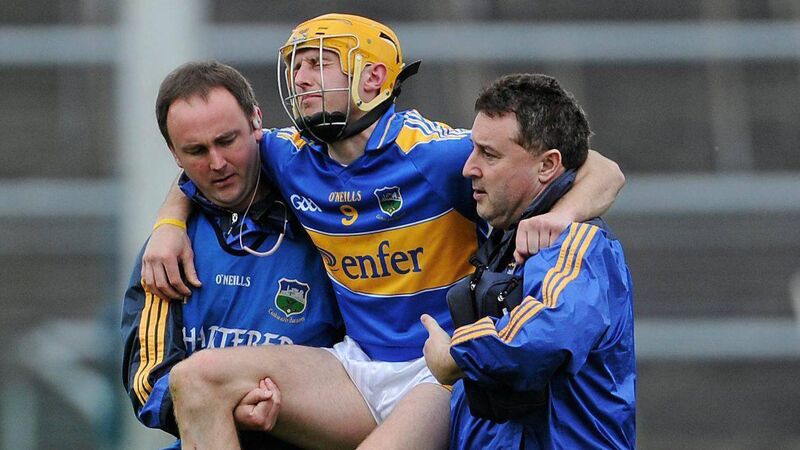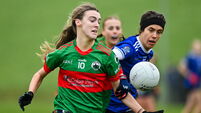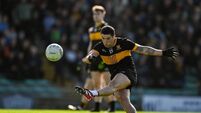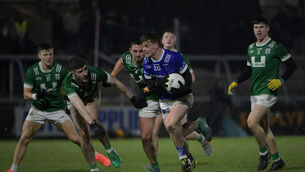Physio John Casey wanted more substitutes to prevent GAA injury carnage

A leading GAA physiotherapist says the limit on substitutes should have been lifted to accommodate the number of unfit players lining out for their clubs in the coming weeks.
Nenagh-based John Casey, physio to Tipperary’s senior hurlers from 2008 to 2012 and Munster Rugby before that, believe managers should have been able to make more than five substitutions given the challenges presented by this year’s condensed season.
“It definitely would have taken some of the impact out of the injuries. If you are smart, you will maximise what you have but if you’re trying to gain what you can’t get it won’t work. Big panels will come into play here, all subs will have to be used and used wisely.
“Fatigue is the biggest cause of injury and most players will be carrying some sort of an injury with them from previous seasons and they need time to prehab that. Almost a pre-pre-season to get yourself up to where you need to be.
“We have had a glut of cruciate injuries over the last few years in the GAA and those boys can’t go straight back into training sessions. They do a month or six weeks of prep before they start pre-season and they’re not getting that, so that cohort of people are really vulnerable at the moment. Those boys probably don’t get off-seasons at all because by the time they are over they are already in getting ready to be up to where the rest of the squad are.”
Casey can’t stress enough the importance of managers appreciating that they won’t be working from a full deck of players.
“Accept that you are not going to be dealing with fit players. What you have to use then is substitutes and switching of players to different positions to get them a break and you really have to be aware of what’s going on around the field.
“If players are struggling with fitness, either they have to come out or go in wherever they can take a breather. There’s going to be a lot of positional moves, I think, to account for that lack of fitness.”
Casey cites the NFL lockout of 2011 where players were prevented from using their team facilities for five months because the parties couldn’t make a collective bargaining agreement. On the resumption of play, there were 10 Achilles ruptures in the first 12 days when the average per season had been four to five.
“They were professional athletes so you would expect them to keep in shape but like the GAA players now they didn’t have access to S&C or physio,” says Casey.
“Those Achilles injuries are career-threatening injuries. With the GAA, guys are coming into the clinic with grade two hamstring tears, which would be somewhere in the region of six-week injuries but they are season-ending injuries now.”
Casey reports higher numbers of GAA players are attending his SportsPlus clinic in Nenagh and it is consistent with Mike McGurn’s warning last week about a pandemic of club injuries and Professor Cathal Moran’s claim that Santry Sports Clinic were already seeing cruciate injuries.
Moran posted on Twitter: “Will limited preparation time for injury prevention and load management result in a tsunami of sports injuries this season?”
Busy morning in theatre @SSCSantry. Interestingly, we are already seeing ACL injuries come through with return to sport. Will limited preparation time for injury prevention & load management result in a tsunami of sports injuries this season? #aclsurgery #gaa #injuryprevention
— Prof Cathal Moran (@CMoransurgeon) July 8, 2020
Casey hopes not but the signs aren’t good. “There is a glut of GAA players coming in and ringing in now with lots of similar type problems, lots of hamstrings and lower back issues. The normal stuff you would see pre-season but you just wouldn’t see as much of it altogether.
“You have a very condensed pre-season and it’s the perfect storm where you have the sudden stop back in March with no set finish to it and lots of rumours with no games so players stop, they have no access to facilities and S&C and physio. From a grinding halt, now everything has been put on them and it’s a rush to try and get back to where they were and it doesn’t work, unfortunately.”
Casey can see how the lack of resources in smaller clubs is hurting their players. “Maybe the lower level clubs who don’t have the access to S&C, they’re doing two things that I set a lot: they’re condensing the pre-season, they’re flogging players to get as fit as they can in as short a space of time as possible and they’re doing generic programmes, which are unsuitable.
“I know there is a club in Tipp who have taken the Tipperary senior fitness programme on their club players and it’s just carnage. They just can’t do what they’re being asked to do physically. You get a club who maybe have a county representative and they bring back a programme and it’s spread out to everybody and it just doesn’t work.”
Players lining out injured is nothing new but the scale over the coming 12 weeks could be considerable.
“It’s the player’s call whether they play or not,” concludes Casey. “We can only advise them and manage the risks but if the player chooses to take the risk there will be further damage. I can see places like Santry doing big business.
“Players will take the risk and they’ll be pushed into it. Some clubs just don’t have the base of players to cover the different levels of senior, intermediate and junior and the secondary teams are going to be very much compromised.”












